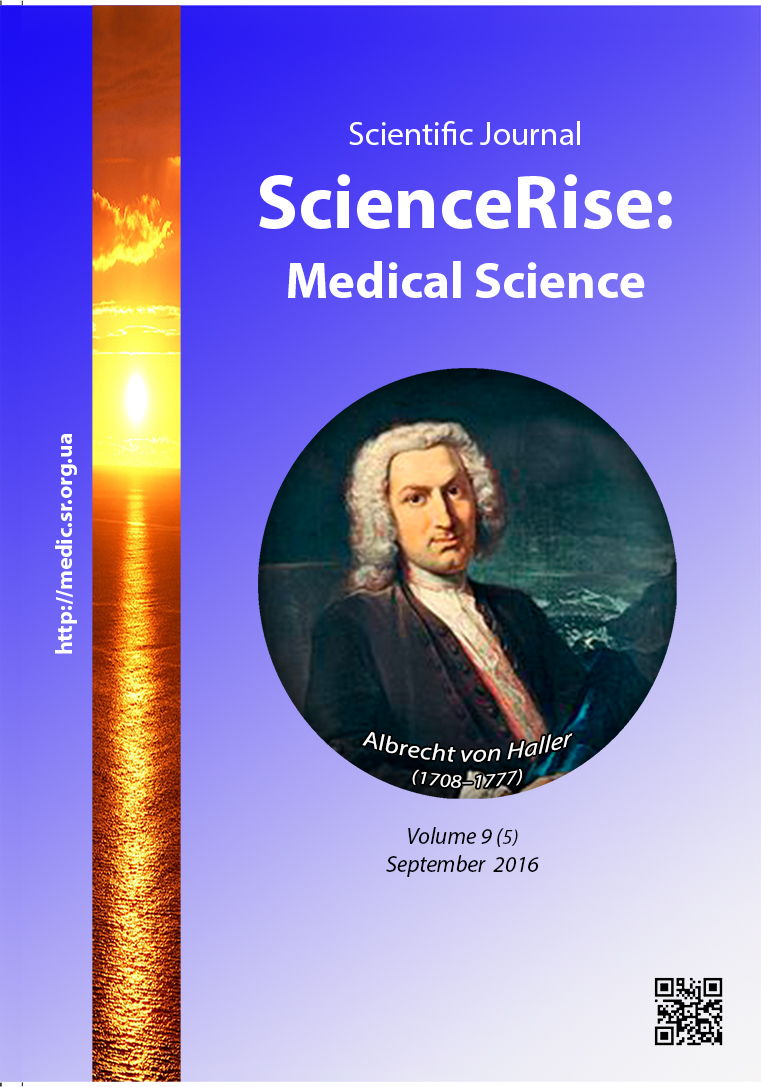The analysis of color choice peculiarities according to the liusher’s test among the emigrants and re-emigrants with depressive disorders
DOI:
https://doi.org/10.15587/2519-4798.2016.77815Keywords:
emigrants, re-emigrants, depressive disorders, method of color choices, pathocharacterological features, main syndromesAbstract
Aim of research – the study of characterological features of emigrants and re-emigrants by the analysis of color choices according to Lusher’s test.
Methods. Examination was carried out using the method of colored choices (modified eight-color test of М. Lusher). Statistical analysis of the results was carried out using the distinct Fisher criterion.
Results. We examined 196 emigrants, 191 re-emigrants and 198 persons that were not emigrants. The new data as to the influence of emigration and re-emigration factor on characterological features of patients with depressive disorders of psychogenic, endogenous and organic character are given in the work. There was demonstrated the formation of pathocharacterological features by hypothymic (dysthymic) type with the predomination of anxious-depressive features in emigrants and astheno-depressive ones in re-emigrants with the most expressed differences in the group of psychogenic depressions and the least expressed ones – in the group of depressive disorders.
Conclusions. The results of research allow talk about the presence of pathocharacterological features by hypothymic (dysthymic) type in studied patients that must be considered within the main syndrome – depressive or anxious-depressive one in the context of influence of socio-psychological factors on the peculiarities of personal transformations. Emigration as a whole must be considered as the factor that favors pathocharacterological development in direction of the anxious-depressive changes and re-emigration – as the factor of astheno-depressive and apatho-depressive personal transformations. The influence of emigration and re-emigration factor on the personal features is mostly manifested in the group of psychogenic depressions and it is the least the group of organic depressive disorders
References
- Kirilenko, Ja., Chumanskaja, E. (2011). Interdisciplinarnye aspekty migracii. Arhiv Nacional'noi' biblioteky im. V. Vernads'kogo, 15/2 (55), 52–53. Available at: http://www.nbuv.gov.ua/old_jrn/Chem_Biol/Tzhp/2011_2/pdf/52-53.pdf
- Migracija v Ukrai'ni: fakty i cyfry (2011). Mizhnarodna organizacija z Migracii'. Kyiv: Predstavnyctvo MOM v Ukrai'ni, 7.
- Shhorichna Dopovid' pro stan dotrymannja ta zahystu prav i svobod ljudyny v Ukrai'ni Upovnovazhenogo Verhovnoi' Rady Ukrai'ny z prav ljudyny: Postanova Verhovnoi' Rady Ukrai'ny vid 05.04.2011 roku № 3194-VI (2011). Golos Ukrai'ny, 35, 23–29.
- Sljusarevs'kyj, M. M., Blynova, O. Je. (2013). Psyhologija migracii'. Kirovograd: Imeks, 242.
- Jurcenjuk, O. S. (2014). Osoblyvosti likuvannja psyhotychnyh psyhichnyh rozladiv u zhinok – trudovyh migrantiv. Molodyj vchenyj, 1 (04), 190–192. Available at: http://nbuv.gov.ua/UJRN/molv_2014_1(04)__44
- Koljanov, V. B., Borjak, V. P., Barnash, N. V., Mihajlenko, L. V. Nekotorye osobennosti psihologicheskoj adaptacii migrantov. CMI. Available at: http://migrocenter.ru/conferences-kavkaz-m_kavkaz030
- Koval'chuk, A. Psyhologichni naslidky trudovoi' migracii' dlja migrantiv ta i'hnih simej. Available at: http://ena.lp.edu.ua:8080/bitstream/ntb/16855/1/26-Kovalchuk-210-216.pdf
- Haustova, O. O. Psyhosocial'na reabilitacija: problemy i shljahy vyrishennja. Arhiv psyhiatrii', 21 (2), 36–42.
- Sobchik, L. N. (1990). Metod cvetovyh vyborov – modificirovannyj vos'micvetovoj test Ljushera. Moscow: MKC, 88.
- Blynova, O. Je. (2013). Psyhologichne zdorov’ja migrantiv: rezul'taty empirychnogo doslidzhennja. Osvita regionu, 2, 244–248.
Downloads
Published
How to Cite
Issue
Section
License
Copyright (c) 2016 Олена Петрівна Венгер

This work is licensed under a Creative Commons Attribution 4.0 International License.
Our journal abides by the Creative Commons CC BY copyright rights and permissions for open access journals.
Authors, who are published in this journal, agree to the following conditions:
1. The authors reserve the right to authorship of the work and pass the first publication right of this work to the journal under the terms of a Creative Commons CC BY, which allows others to freely distribute the published research with the obligatory reference to the authors of the original work and the first publication of the work in this journal.
2. The authors have the right to conclude separate supplement agreements that relate to non-exclusive work distribution in the form in which it has been published by the journal (for example, to upload the work to the online storage of the journal or publish it as part of a monograph), provided that the reference to the first publication of the work in this journal is included.









